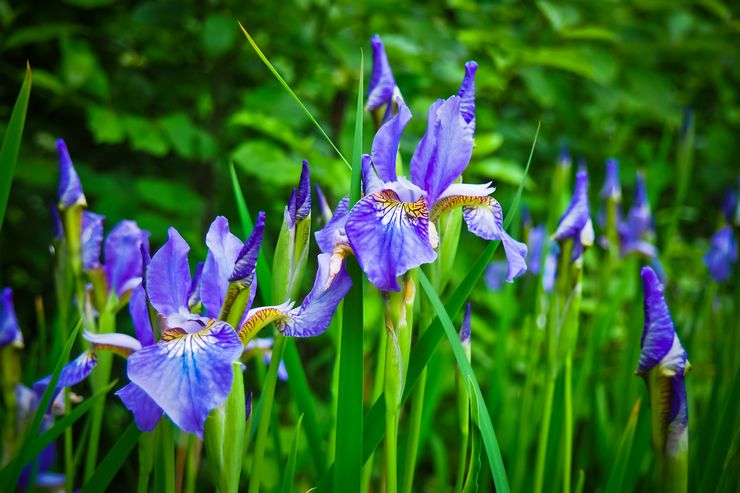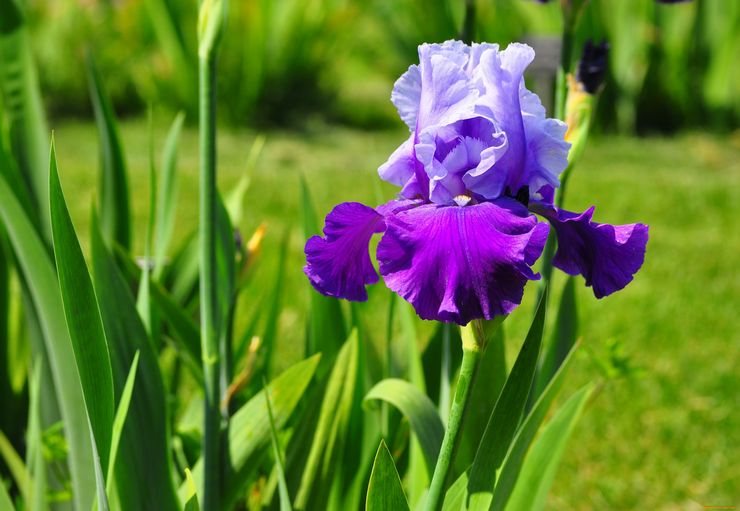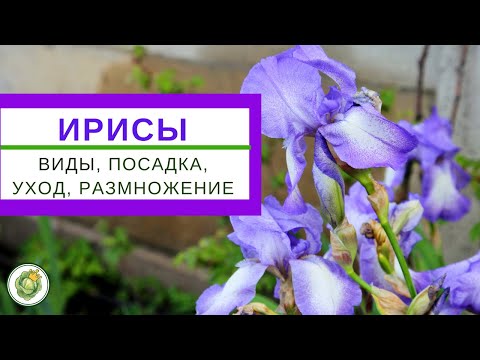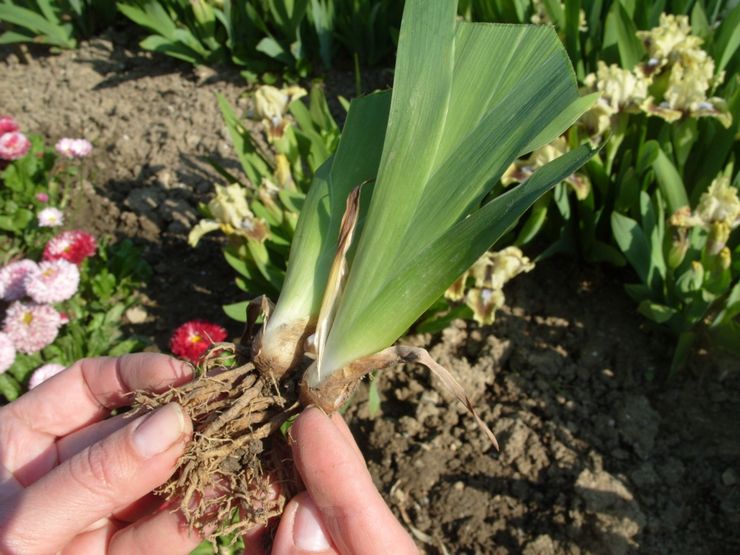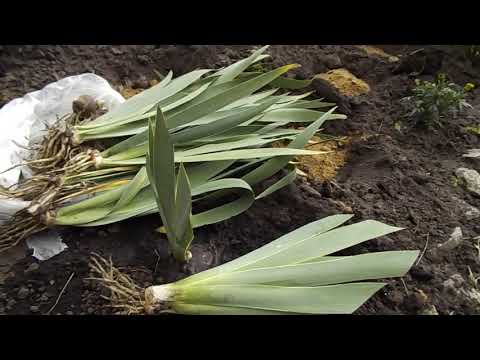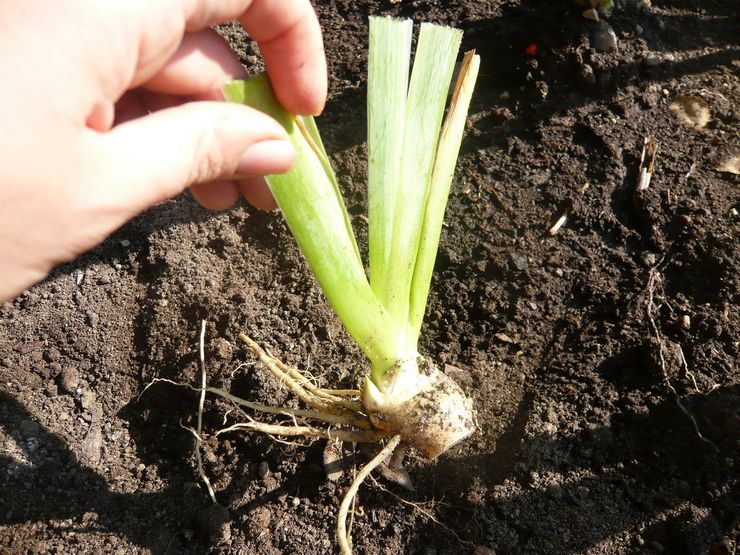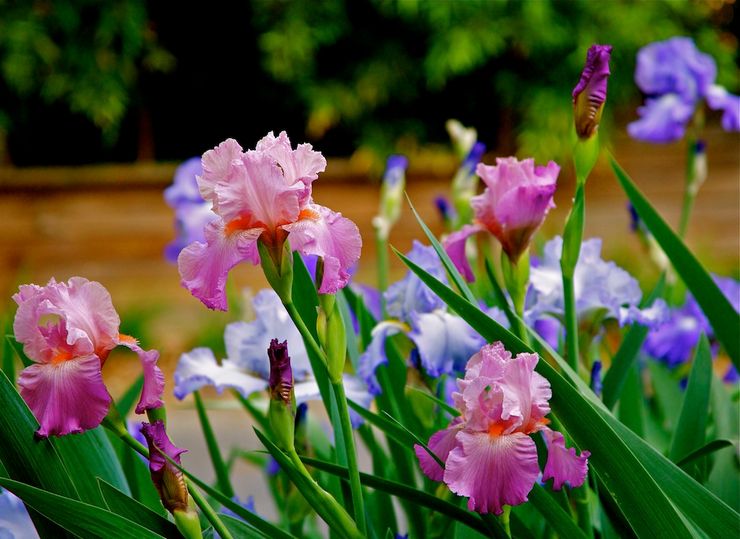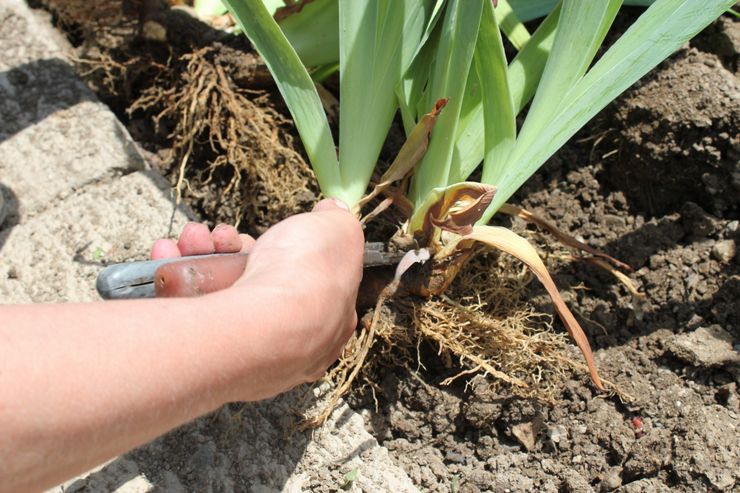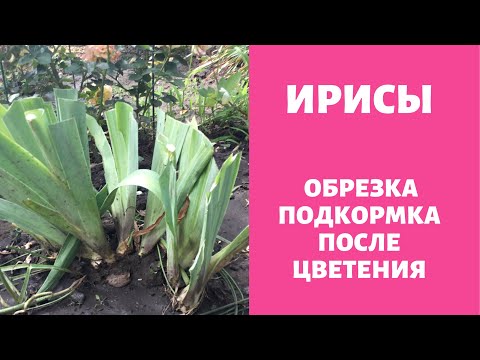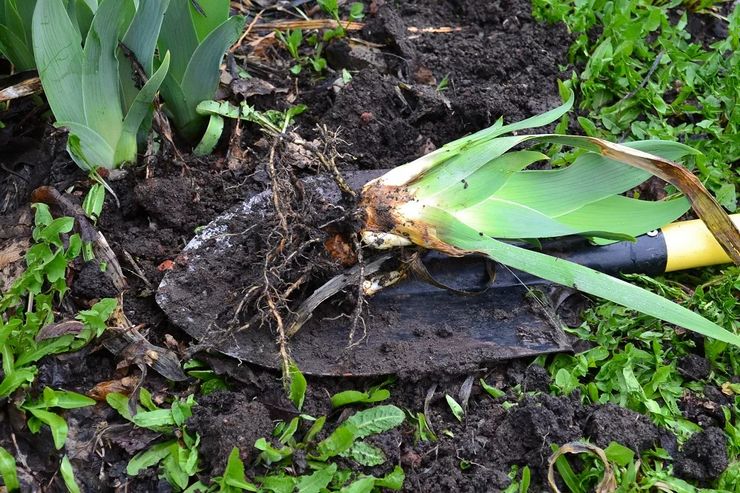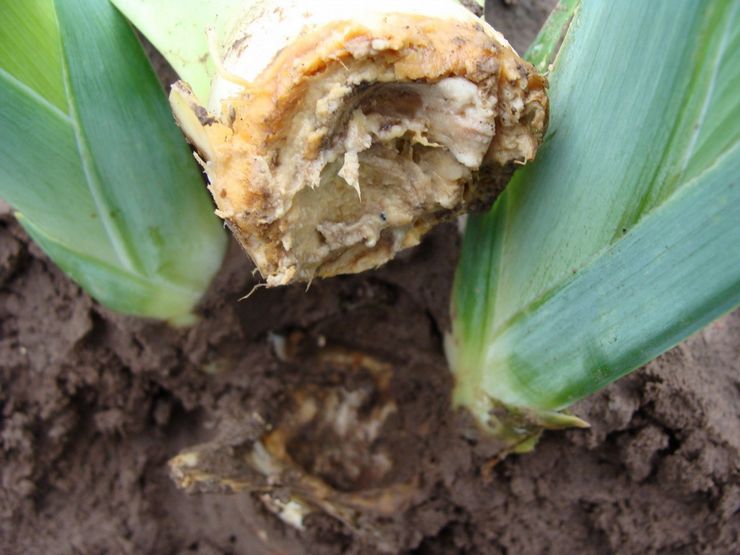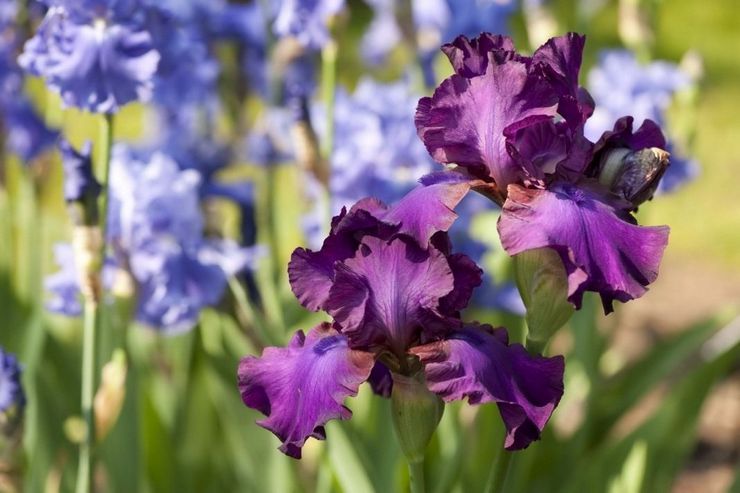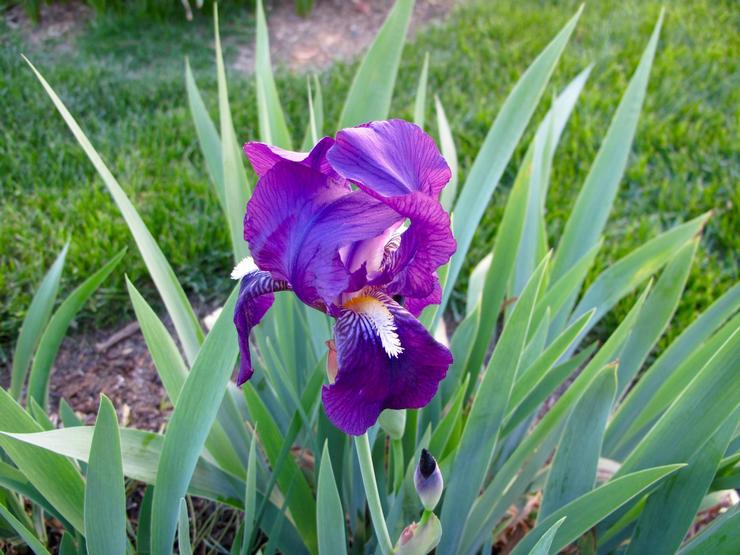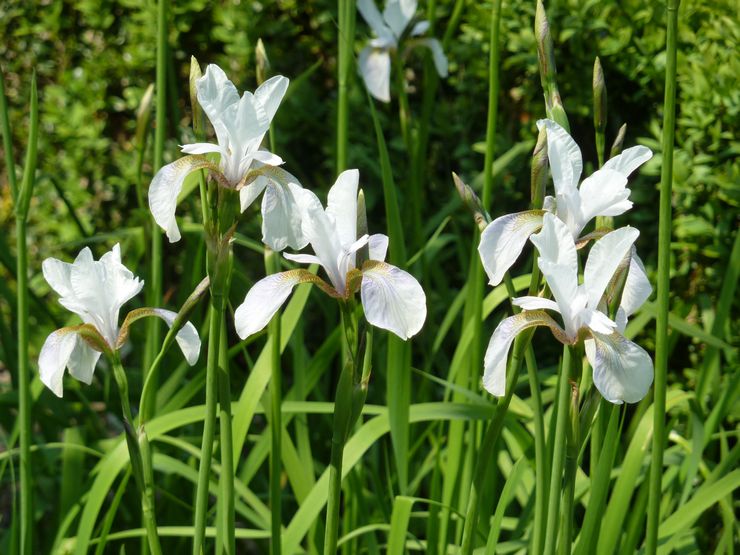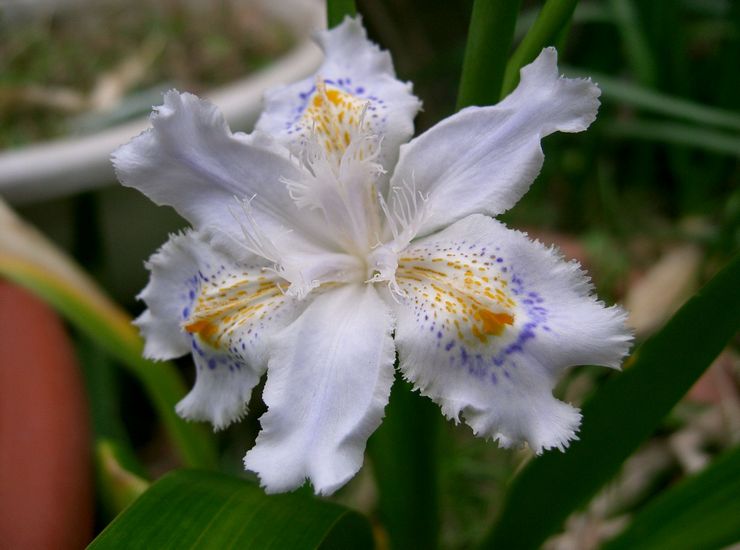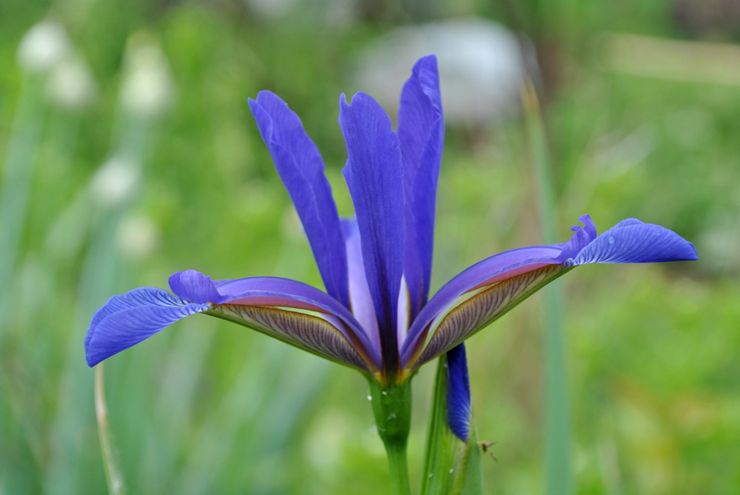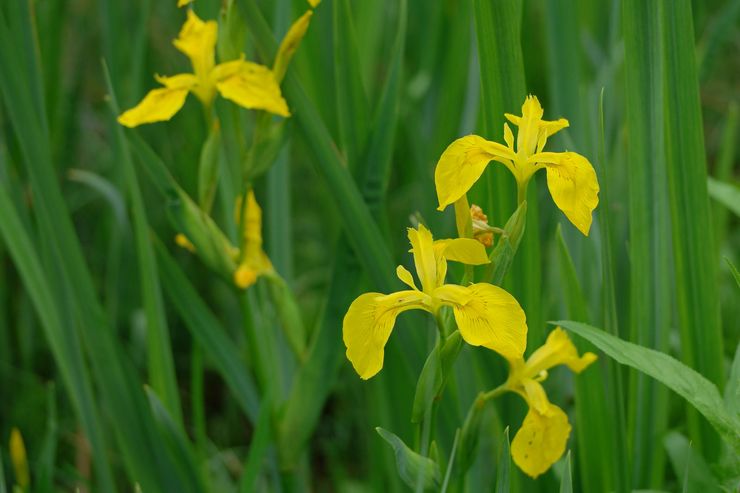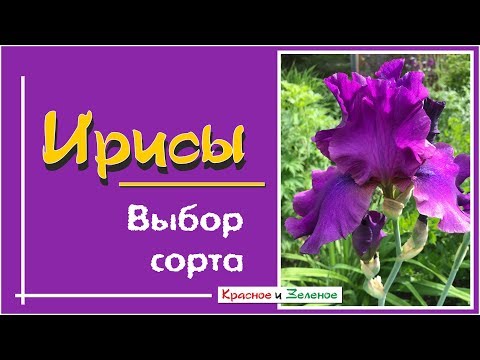The iris plant (Іris) is a representative of the Iris family, also called iris. Another popular name for this flower is cockerel. Irises live in almost all corners of the Earth. Their genus includes almost 700 different species..
The scientific name of the plant comes from the word “rainbow”: Irida was the name of the ancient Greek goddess of this natural phenomenon. According to legend, irises appeared on the planet after Prometheus got fire for people, and a rainbow shone in the sky for a long time after his feat. It was with her that people compared unusual flowers. The numerous colors of irises and the spectacular play of their petals are truly reminiscent of rainbow colors. It is noteworthy that according to one of the legends, the famous Italian Florence owes its name to irises. These flowers filled the fields near the city, which is why it was called “blooming”.
Iris has been known to mankind for over 2 thousand years. These unpretentious plants can not only decorate flower beds. Irises are used in folk medicine, as well as in production for the manufacture of perfume essences. At the same time, the essential oil extracted from the rhizomes has the smell of a completely different flower – violets, which is why this part of the plant is sometimes called the “violet root”. In addition, these flowers can also be found in industry and food..
Description of iris
Iris has a strong rhizome, from which fairly thin filamentous roots extend. From the main rhizome, flat leaves grow in two rows. They have a xiphoid (less often linear) shape and are covered with a thin waxed layer. A number of leaf plates are arranged in a fan-like manner. The stems have practically no foliage. One plant can form one or several peduncles at once. Flowers are most often solitary, but occasionally they can form a small inflorescence.
Iris flowers have a delicate aroma and large size. They are distinguished by a recognizable shape and variety of colors. Each flower has 6 petals – perianth lobes. The three outer lobes are bent downward, and the inner ones are directed upward and form a kind of tube. The color of the outer and inner petals may differ. Iris bloom can last from May to mid-summer. In many ways, its onset and duration depend on the type and variety of the plant. Up to 3 buds can bloom on one bush at the same time. Flowers last up to 5 days. After their wilting, seed pods are formed..
Along with rhizomes, there are also species growing from bulbs. They are classified as an independent genus..
IRISES – varieties, planting, care, reproduction
Brief rules for growing irises
The table shows short rules for growing irises in the open field..
| Landing | You can plant a plant throughout the warm season.. |
| The soil | Flowers grow best in well-drained soil, where water does not stagnate. At the same time, a nutritious soil is always required.. |
| Lighting level | The plant prefers warm and bright places.. |
| Watering mode | Flowers need periodic watering. It is especially important to monitor soil moisture during the period of bud formation. The rest of the season, you will have to water the plants only if the soil in the holes is completely dry.. |
| Top dressing | Flowers cannot be fed with organic matter: in such soil, their rhizomes can rot. Liquid mineral formulations are suitable for feeding.. |
| Bloom | Flowering begins in late May – early June and lasts until about mid-July. |
| Pruning | In the summer, when the foliage of the plants begins to turn yellow, or in the fall, shortly before wintering, it should be cut. |
| Pests | Scoops, gladiolus thrips, slugs. |
| Diseases | Fusarium, spotting and various rot. |
Planting irises in open ground
Landing features
Irises should not be considered difficult plants to grow. With proper care, they manifest themselves as extremely unpretentious flowers. But before planting rhizomes, you should remember the main features of the development and principles of planting irises in open ground.
The rhizome of the plant spreads horizontally underground. As they grow, they can partially come out to the soil surface. The exposed portion of the rhizome often makes the flower more sensitive to frosty weather. Before the onset of cold weather, it is recommended to cover these areas with earth or peat. In the spring, the cover layer is carefully removed.
Bearded irises are especially sensitive to the level of burial. It is recommended to plant such plants on the sand. A sand hill is poured into the hole, on which the rhizome is spread. After straightening the roots, you can cover the plant with soil, leaving a convex area on the surface under the leaf blades. Irises grow best when warmed by the sun.
As the rhizomes grow, irises are able to move their rosette, moving away from the planting site. In one summer, the bush can move several centimeters. To make the rows of plantings look neat, it is worth placing fans of foliage along the rows. Due to the same feature, irises will need periodic transplants..
CORRECT LANDING OF IRIS – IF YOU ADHERE TO THESE RULES, THE IRIS WILL FLOWER EVERY YEAR.
The best time and place to land
Irises can be planted throughout the warm season. If the plants need replanting, this can be done immediately after flowering, or even in early autumn, if it promises to be long and warm. The main thing is to transplant flowers at least a month before the onset of cold weather. Due to the growth of rhizomes, plants are transplanted quite often: once every 3-4 years, although Siberian varieties are able to grow in the old place longer – up to 10 years. Without a timely transplant, irises stop forming buds.
The place for planting irises is chosen based on their type. Bearded species need a sunny corner, sheltered from cold drafts. They grow best in drained soil, where water does not stagnate, which is why they are usually located on higher ground. Siberian and marsh species, on the other hand, prefer wetter places. At the same time, all irises require nutritious soil..
Before spring planting, poor soil is fertilized with compost, mixed with more fertile soil and potassium-phosphorus compounds are added there. You can also add a very weak nitrogen fertilizer there. If the soil is too acidic, it is supplemented with chalk, wood ash or dolomite flour. On acidic soils, irises bloom less abundantly, or do not bloom at all, but they develop foliage well. Peat and sand are added to heavy loamy soils, and sandy soils can be slightly heavier with clay.
In addition, any soil before planting will need to be disinfected: it is spilled with a fungicide. It is forbidden to bring organic compounds to iris beds due to the sensitivity of plants to this type of fertilizer.
Planting irises in spring
If irises were purchased shortly before spring planting or were stored in winter, they should be treated with a growth stimulant. Long thin roots are trimmed and dry or decayed areas are removed. The rhizome itself is kept for about 20 minutes in a solution of potassium permanganate for disinfection.
It is necessary to plant the rhizome of the bearded iris in a medium-sized hole on a slide of sand. It must remain horizontal. After that, the roots of the seedling are straightened and sprinkled with soil, leaving only the upper section of the rhizome above the ground. After planting, irises are watered. Beardless species are planted according to the same scheme, but at the same time their rhizomes are completely buried. After planting, their holes can be mulched with peat or needles to maintain soil moisture. The distance between plants should be about half a meter..
Caring for irises in the garden
All irises prefer warm and bright places, and also need periodic watering. It is especially important to monitor soil moisture during the period of bud formation. For the rest of the season, irises will only have to be watered if the ground in the holes is completely dry. Abundant watering at the end of summer can activate the growth of bushes, which is not required before wintering..
Top dressing
Irises cannot be fed with organic matter: in such soil, their rhizomes can rot. Liquid mineral formulations are suitable for dressing. If, before planting the bushes, top dressing was introduced into the ground, you will not have to feed the irises anymore. In other cases, you can use liquid potassium-phosphorus compositions for flowers. They are used during the development of the leaf outlet, but not during flowering..
Irises. Care and reproduction.
Weeding
Weeding iris beds is carried out only by hand. The rhizomes of the bushes are shallow, so the risk of damaging them with a hoe increases. In this case, the soil in the holes can be periodically gently loosened. Timely removal of wilted flowers can protect plantings from the development of diseases.
Bloom
The flowering of irises depends not only on compliance with the conditions of care in the open field, but also on the size of the rhizome, as well as on the number of leaf blades it forms. If there are at least 7 of them, the iris should bloom next spring. Small divisions planted at the end of summer will most likely bloom only in the second year after transplanting..
Irises after flowering
When to prune irises
After the irises have bloomed, their peduncles should be removed at a level of 2 cm from the ground. For this, a sharp instrument is used. In some cases, such actions will help to cope with self-seeding, although in most species the seeds in the capsules do not ripen. If the irises can bloom again – closer to autumn, you should not touch the flower stalks until the second flowering. Instead, they simply remove individual wilted buds along with the receptacle..
In the summer, when the foliage of the plants begins to turn yellow, or in the fall, shortly before wintering, it should be cut off, leaving only a third of the total height. As a rule, the fan of leaves is cut in the form of a semicircle or a diamond. The central leaves in this case will be the longest, and the lateral ones will be the shortest. This shape allows the foliage not to accumulate excess moisture. Pruning helps the plant to conserve vigor for the new season and also to keep it looking neat. The cut parts of the leaf plates are destroyed: bacteria or pests can accumulate there.
The degree of shelter of irises for the winter depends on their type. After the establishment of cold weather, around November, the bare rhizomes are sprinkled with soil and a thick layer of sand or peat. Its size should be about 10 cm. If there is a risk of a winter with little snow, more thermophilic varieties can also be covered with dry foliage or spruce branches. If winter promises to be snowy, the irises will not need additional shelter. Excessive warming measures can, on the contrary, harm the plantings – the plants will simply rot.
It is not necessary to cover frost-resistant species of bearded irises, but you can cover them with spruce branches or use a covering material. So the plants will preserve the air gap under the layer of snow..
Prune irises and fertilize correctly after flowering !
Storing irises in winter
If bearded irises were purchased in the autumn, or they were dug up, but did not have time to plant before frost, the rhizomes can be preserved until spring. The planting material is stored in a dry and cool place. The rhizomes are pre-dried and then folded into a tightly closed cardboard box. Each plant must be wrapped in paper or dry cloth, or sprinkled with dry sawdust or peat over the rhizomes. In winter, the container with irises can be kept on a closed balcony.
Moisture-loving iris species will not be able to withstand dry wintering, therefore, to preserve them, they are planted in containers. Before planting, the roots of the plants are shortened, and the rhizome is kept for some time in a solution of potassium permanganate of medium saturation. After drying, the irises are planted in a container, trying to deepen them only slightly. In the spring, such bushes are transferred to the beds along with a lump of earth..
When to transplant irises
In the fall, faded irises are most often planted in need of transplantation. It is recommended to do this during August-September, but earlier dates of planting the cut will allow the plants to better take root in a new place until winter..
The iris bush is pry off with a pitchfork, and then the parts that have their own leaf fan are separated. Long roots shorten, and also clean the roots of decayed areas. It is also recommended to cut about 2/3 of the length of the foliage so that all the forces of the plants go to rooting..
The resulting cuttings are kept in a saturated solution of potassium permanganate for about two hours. After that, they need to be dried in the sun for several hours. Landing is carried out according to the same principle as in the spring. The distance between the holes is calculated based on the height of the variety. It can be from 15 to 50 cm, and depending on the size of the bushes.
Pests and diseases
The more spectacular an iris variety looks, the more sensitive it can be. Such plants are usually affected by diseases and pests in the first place, but simpler species are not immune from them. The best prevention of iris diseases is considered to be the observance of the agricultural technology of these flowers. When the first signs of the disease appear, you must immediately start treating the plantings..
If the irises are struck by fusarium, the diseased bushes will have to be destroyed. The rest of the plantings are watered with a 2% Fundazole solution. You can also use this drug for preventive treatment of rhizomes before planting. This will reduce the chances of developing rot. Bordeaux mixture is used against stains. Its 1% solution is sprayed on plant foliage. If the rot has not affected the entire rhizome, it is possible that the flower can still be saved. All affected areas are cut to healthy tissue, treated with a disinfectant, and then thoroughly dried the rhizome in the air during the day, periodically turning it over. The soil from the hole in which the iris began to rot should be removed.
Moths can settle on irises. They most of all harm the peduncles, eating them at the base. Because of their appearance, the peduncles begin to turn yellow and dry. Timely prevention helps best against the scoops: at the very beginning of the growth of the bushes, it is necessary to treat them with karbofos (10% solution), and then repeat the procedure after a week.
Another pest of irises is gladiolus thrips. These insects can negatively affect the process of photosynthesis, due to which the foliage of plants turns brown and dries up. At the same time, the buds become deformed and lose color. Most often, thrips attack plantings in summer, during periods of heat and drought. You can also use a solution of karbofos against them. An infusion of makhorka is considered no less effective. 400 g of the substance is kept in water for about 1.5 weeks, and then 40 g of grated laundry soap is added to the composition.
Traps can be used against slugs that sometimes appear in the beds: burdock leaves or a damp cloth. Pests gather under cover, after which it remains only to collect them. If the slug colony is too large, metaldehyde pellets can be used. They are scattered over the beds in the morning or evening on a clear day. For 1 sq. m will require about 35 g of substance.
Types and varieties of irises with photos and names
Bearded irises
All rhizome species of irises are divided into two main categories: bearded and non-bearded. In the first group, noticeable villi are present on the petals, while in the second they are absent. Bearded species have their own internal classification, dividing plants according to height, flower size and other similar characteristics, but in gardening they rarely go into such details, referring all such plants to the general group of bearded.
German Iris (Iris germanica)
The most common type species of bearded irises, practically not found in nature. Iris germanica is considered the progenitor of many garden varieties. Such plants have bluish-green foliage, up to 1 m in height and large flowers, most often purple-yellow in color. They appear at the end of spring. The petals of these colors can be smooth or corrugated. The fruits ripen by the end of summer. The rhizomes of these species are considered edible and can also be used for medicinal purposes. Such plants are especially popular in the States..
Of the several hundred varieties of Germanic iris, the most famous are:
- Acoma – pale blue petals interspersed with a cream shade and lavender border.
- Baltic Sea – flowers with corrugated petals of blue-blue color with blue villi “beards”.
- Beewilderbeest – wavy petals have a burgundy-cream color and are complemented by light yellowish-white specks.
Non-bearded (beardless) irises
Such irises have no characteristic “beard”. Of all the species belonging to this group, the following are most often found in mid-latitudes:
Siberian Iris (Iris sibirica)
This species is highly frost-resistant. In addition, he is not afraid of the wind, despite the impressive height of the stems, and is also able to endure partial shade. Despite the popularity of bearded fellows, this particular type of irises is considered the most unpretentious and adapted to the whims of nature. Iris sibirica flowers are odorless but come in many different colors. There are about a thousand varieties derived from such a plant. Among them:
- Butter & Suga – yellow flowers with a white border.
- Imperial Opal – bushes up to 80 cm high with pinkish lavender flowers.
- Snow Queen – with snow-white flowers.
Japanese Iris (Iris japonica)
Either Kempfler or the xiphoid. Such plants can have different stem heights and flower sizes. They can also appear at different times. Because of the confusion in the names, Iris japonica is sometimes called an evergreen species that grows in the tropics. At the same time, the group of xiphoid irises still continues to be called Japanese – according to their place of origin. In Japan itself, this species is called “hana-shobu”. Their flowers have no scent. Such plants have low frost resistance, and also require frequent watering. Most often they are grown in warm regions, although there are a number of varieties that are more resistant to cold weather. Among them:
- Vasily Alferov – bright rich ink flowers.
- Nessa no mei – large pale purple flowers up to 23 cm.
- Solveig – light lilac flowers.
Iris spuria
This species is distinguished by spectacular velvety perianths of burgundy-red tones. Iris spuria can grow in one place for a long time – up to 10 years. In nature, he lives in steppes or semi-deserts. This is due to the high resistance of the bushes to heat and salty soils. Their flowers do not have a scent. The first varieties of such irises appeared not so long ago – in the 60s of the last century. Among the most common:
- Lemon Touch – openwork lemon flowers with a golden signal spot. The sizes of the peduncles reach 1 m.
- Stella Irene – bushes up to 90 cm tall, flowers are painted in a dark purple hue and are complemented by a medium-sized golden spot.
- Transfiguration – meter bushes with bluish-purple petals and a bronze-orange spot-signal.
Marsh iris (Iris pseudacorus)
Or yellow, false aira. In nature, it lives in very humid, coastal river or wetland areas. Iris pseudacorus seeds are able to spread through water: this is possible due to their special structure. In garden conditions, it successfully gives self-seeding, sometimes turning into a difficult-to-remove weed: it is not easy to extract young seedlings from the soil. But, in order to prevent the uncontrolled spread of plantings, you should only remove wilted flowers in a timely manner..
Light cuts of the roots of this species in the air begin to quickly acquire a brown color. Thanks to this feature, rhizomes were previously used in leatherwork: a brown dye was obtained from this part of the flower. On branched stems there is not a pair, but about a dozen flowers. Their upper petals are several times smaller than the lower ones. The color of the flowers in most cases is yellow..
Due to the moisture-loving nature of this iris, it is most often located near garden ponds. The most common varieties are:
- Golden Queen – with yellow flowers.
- Flore Pleno – with golden yellow double petals.
- Umkirch – pink-flowered variety.
IRISES. How to choose the best garden variety?
There is also a general classification of various varieties of irises according to the type of color of their flowers:
- Monochromatic – all petals of the flower are painted in the same color.
- Two-tone – the outer and inner lobes are painted in different shades of the same color.
- Bicolor – outer and inner petals have different colors.
- Amena – inner petals are white.
- Variegata – the inner lobes are yellow, and the outer ones are red-brown.
- Bordered (plikata) – the outer lobes or all the petals are immediately supplemented with a contrasting border.
- Iridescent – flowers are distinguished by delicate color transitions.

